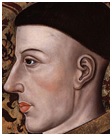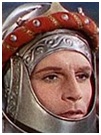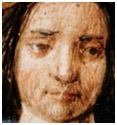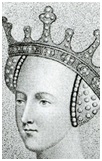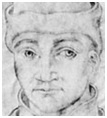|
 |
|
 |
|
|
||
The Battle of Agincourt, Henry V and Leadership
The Battle of Agincourt (1415)
Famous for... 1. Henry V’s victory over the French. Henry V (pictured right) had become the English king in 1413, when his father, Henry IV, died.
2. The English longbow This was crucial to the English victory.
3. Shakespeare Shakespeare's play, Henry V, included the battle and Henry's inspirational speeches. In 1944 the great English actor, Laurence Olivier (pictured right as Henry V), made the play into a film which was used as a morale booster during World War Two. Shakespeare describes Henry’s youth in Henry IV Parts 1 and 2, starring one of his favourite comical characters, Falstaff.
Key events in 1415
14 August Henry and his army (around 12,000 men) land in Northern France, near the Breton port of Harfleur which he besieges.
22 September Harfleur surrenders.
8 October Having lost a third of his army to disease and death, Henry starts his march to Calais (then under English rule).
25 October The Battle of Agincourt (pictured below with the English on the right).
Where is Agincourt? Near the village of Azincourt in northern France, 30 miles (48 km) south of Calais.
The opposing armies at Agincourt
English 1,000 infantry. 5,000 (or 6,000) archers. The archers protected themselves by putting angled wooden stakes in front of them.
French 25,000 (largely infantry and cavalry).
So the English were outnumbered by 4 to 1 with hungry, sick and tired troops (they’d marched 260 miles in 2½ weeks). This made their victory quite astonishing.
What happened in the battle After overnight rain, the armies stood 700 yards (640 metres) apart in a muddy, ploughed narrow field between two woods, near to the village of Agincourt. Henry then moved to within 300 yards of the enemy to provoke a French attack. Fortunately for him, this attack was delayed long enough for his archers to re-plant their protective wooden stakes. The French were crushingly defeated by:
The French were hampered by the mud, heavy armour (weighing 60 to 70 pounds) and the small battlefield. They were so cramped that they:
It was impossible for them to get up, and they were either killed or suffocated by the mud or other bodies. So French casualties were high...
Casualties
French Five to ten thousand.
English Maximum 200.
Why Henry won
1. Poor French leadership and organization The French:
The French king, Charles VI (pictured right) had just had a nervous breakdown. So the French were indecisive and, after Henry’s advance, failed to attack him before he could re-plant the stakes to protect his archers.
2. Luck The heavily armoured French were slowed down by the:
3. Military intelligence The English knew the French battle plan.
4. The English longbow The longbow (pictured below) was devastatingly effective:
5. Henry’s brilliant leadership Please see the next section.
Why was Henry such a great leader?
1. Strategy Henry's advance was risky but won the battle by provoking a French attack. He also fully exploited his key advantages:
2. Communication, control and character Henry was in total control of his troops He also motivated them by:
The speech wasn’t great oratory (as in the Shakespeare play), but reminded them that they would die, if they lost.
3. Purpose and energy Henry was fanatically driven by his:
This gave him:
He was a workaholic and, even on his deathbed, was so preoccupied with work that he didn’t even see his wife, Catherine (pictured right)!
4. Bravery Henry always led from
the front. At Agincourt, his bravery was shown by his:
5. Innovation Henry successfully introduced the use of angled wooden stakes in front of his archers to protect them.
6. Learning Henry read lots of books and learned from:
7. Ruthlessness Henry ordered the killing of around 1,500 unarmed French prisoners, when he thought the outcome of the battle was still uncertain.
What happened after the battle
1417-21, Henry at war in France He captures Caen and Rouen in Normandy.
Treaty of Troyes (1420) The French king, Charles VI, recognizes Henry as his heir. Henry agrees to marry Charles’s daughter, Catherine. Henry dies (1422) After his people are increasingly unhappy about his expensive wars and long absences in France, Henry's nine-month-old son, Henry VI (pictured right), becomes king.
Best book John Keegan, The Face of Battle (1976). |
|
|
||
|
|
||
| Copyright © wisdomtowin.com 2025 All Rights Reserved | ||
|


